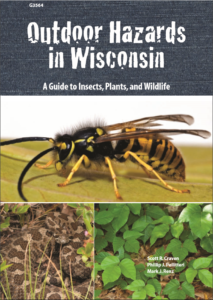 Published by the University of Wisconsin-Madison Division of Extension, this guide will help you recognize, avoid and handle potential problems caused by wildlife, insects or plants.
Published by the University of Wisconsin-Madison Division of Extension, this guide will help you recognize, avoid and handle potential problems caused by wildlife, insects or plants.
Contents:
- Amphibians (salamanders, toads)
- Reptiles (turtles, snakes)
- Birds (defending territory, handling birds)
- Mammals (short-tailed shrews, bats, skunks, porcupines, coyotes, gray wolves, deer, black bears)
- Stinging insects (bees and wasps)
- Blood-feeding insects (mosquitoes, deerflies and horseflies, blackflies, biting midges, ticks, chiggers)
- Plants that are poisonous when ingested (poison hemlock, spotted water hemlock, bittersweet nightshade, black nightshade, jimsonweed)
- Plants that are poisonous on contact (poison ivy, poison sumac, wild parsnip, stinging nettle)
- Plants that cause hay fever (common ragweed, giant ragweed)
- Thorny, barbed plants (bull thistle, beggarticks, burdock, cocklebur, sandbur)
(Visited 1,183 times, 3 visits today)
